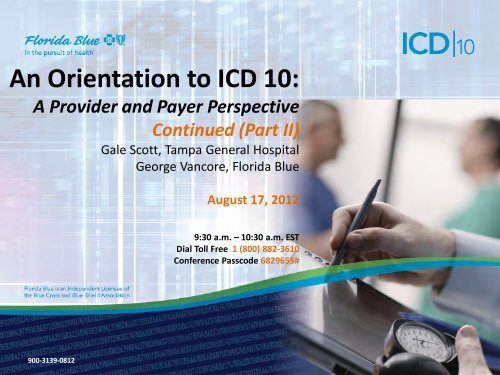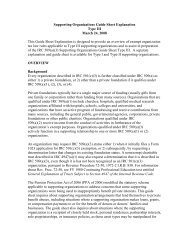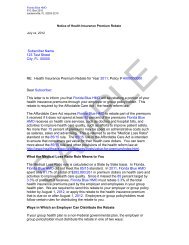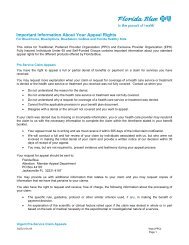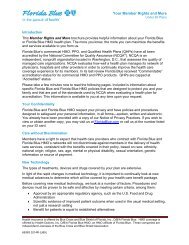An Orientation to ICD 10: - Florida Blue
An Orientation to ICD 10: - Florida Blue
An Orientation to ICD 10: - Florida Blue
- No tags were found...
You also want an ePaper? Increase the reach of your titles
YUMPU automatically turns print PDFs into web optimized ePapers that Google loves.
<strong>An</strong> <strong>Orientation</strong> <strong>to</strong> <strong>ICD</strong> <strong>10</strong>:A Provider and Payer PerspectiveContinued (Part II)Gale Scott, Tampa General HospitalGeorge Vancore, <strong>Florida</strong> <strong>Blue</strong>August 17, 20129:30 a.m. – <strong>10</strong>:30 a.m. ESTDial Toll Free 1 (800) 882-36<strong>10</strong>Conference Passcode 6829655#900-3139-0812
<strong>An</strong> <strong>Orientation</strong> <strong>to</strong> <strong>ICD</strong> <strong>10</strong>:A Provider and Payer PerspectiveSession Objectives:1. To increase your understanding of the current state of <strong>ICD</strong>-<strong>10</strong>; recentregula<strong>to</strong>ry decisions and industry perspectives.2. Increase your awareness and understanding of the challenges that<strong>ICD</strong>-<strong>10</strong> brings <strong>to</strong> Providers and Payers.3. To provide you with some <strong>to</strong>ols, techniques and helpful hints thatcould be used as you begin your <strong>ICD</strong>-<strong>10</strong> preparations.2
<strong>An</strong> <strong>Orientation</strong> <strong>to</strong> <strong>ICD</strong> <strong>10</strong>:Current State• On February 2, 2012, the AMA sent a letter <strong>to</strong> DHHS requesting that they consider delaying theimplementation of <strong>ICD</strong>-<strong>10</strong>:http://www.ama-assn.org/resources/doc/washing<strong>to</strong>n/icd-<strong>10</strong>-comment-letter-02feb2012.pdf• On February 16, 2012, the DHHS announced its intent <strong>to</strong> delay <strong>ICD</strong>-<strong>10</strong>:https://www.cms.gov/Medicare/Coding/<strong>ICD</strong><strong>10</strong>/downloads//HHSPressRelease<strong>ICD</strong><strong>10</strong>final321612.pdf• On March 15, 2012, CMS/WEDI issued a summary report on the most recent <strong>ICD</strong>-<strong>10</strong> readiness survey:http://wedi.org/cmsUploads/pdfUpload/commentLetters/pub/WEDI_<strong>ICD</strong>-<strong>10</strong>_Progress_Survey_Final_[03-16-2012].pdf• On April 9, 2012, DHHS announced a proposed rule that would delay the compliance date for <strong>ICD</strong>-<strong>10</strong>from Oc<strong>to</strong>ber 1, 2013 <strong>to</strong> Oc<strong>to</strong>ber 1, 2014:https://www.cms.gov/apps/media/press/release.asp?Counter=4329&intNumPerPage=<strong>10</strong>&checkDate=&checkKey=&srchType=1&numDays=3500&srchOpt=0&srchData=&keywordType=All&chkNewsType=1%2C+2%2C+3%2C+4%2C+5&intPage=&showAll=&pYear=&year=&desc=&cboOrder=date• On June 19, 2012, delegates at AMA's <strong>An</strong>nual Meeting adopted a policy <strong>to</strong> evaluate <strong>ICD</strong>-11 as analternative <strong>to</strong> replace <strong>ICD</strong>-9. The AMA will conduct more research on this issue and will report back <strong>to</strong>the House of Delegates in 2013.http://www.ama-assn.org/ama/pub/news/news/2012-06-19-ama-adopts-new-policies.page• UPDATE: On August 8, 2012, DHHS sent the <strong>ICD</strong>-<strong>10</strong> Final Rule <strong>to</strong> OMB (Office of Management andBudget) which is the last step before publication. We are hoping that OMB’s review and approval willoccur this month.3
<strong>An</strong> <strong>Orientation</strong> <strong>to</strong> <strong>ICD</strong> <strong>10</strong>:A Regula<strong>to</strong>ry View – Fundamentals• In January 2011, the DHHS announced the final rules for new medicaldiagnosis and procedure code sets (<strong>ICD</strong>-<strong>10</strong>) under HIPAA-AS.• The successful implementation of the new electronic transaction standard(HIPAA 50<strong>10</strong>) is a pre-requisite <strong>to</strong> the implementation of <strong>ICD</strong>-<strong>10</strong>.• <strong>ICD</strong>-<strong>10</strong> is intended <strong>to</strong> improve clinical data reporting, improve patient carequality, enhance claim processing and promote increased interoperabilityacross industry stakeholders.• Significant impacts <strong>to</strong> provider billing and payment processing may berealized across the health care industry if stakeholders fail <strong>to</strong> collaborate,coordinate and communicate on their <strong>ICD</strong>-<strong>10</strong> initiatives.4
<strong>An</strong> <strong>Orientation</strong> <strong>to</strong> <strong>ICD</strong> <strong>10</strong>:A Regula<strong>to</strong>ry View – Fundamentals• The <strong>ICD</strong>-<strong>10</strong> CM (Clinical Modifications) and <strong>ICD</strong>-<strong>10</strong> PCS (Procedure Coding Structure)are the new medical diagnosis and procedure code sets under HIPAA-AS.• These new code sets represent a fundamental overhaul <strong>to</strong> the current <strong>ICD</strong>-9coding system.• <strong>ICD</strong> codes are used <strong>to</strong> codify medical diagnoses and procedures, calculateand adjudicate coverage, compile medical statistics, assess quality of careand help manage clinical quality outcomes for patients.• The current <strong>ICD</strong>-9 codes sets are outdated and do not reflect advances inmedical technologies nor are they descriptive enough.5
<strong>An</strong> <strong>Orientation</strong> <strong>to</strong> <strong>ICD</strong>-<strong>10</strong>A Regula<strong>to</strong>ry View – Fundamentals• As highlighted in the final rule, the new <strong>ICD</strong>-<strong>10</strong> CM and PCS code sets areintended <strong>to</strong>:• Provide greater flexibility <strong>to</strong> enable future capabilities.• Provide more descriptive and robust categories for precise coding.• Enable streamlined reimbursement processes.• Provide richer medical data with higher degrees of details andquality for further analysis; help enrich clinical care profiles andpatient outcomes.• Maximize the value of clinical data and the business value ofinteroperability of e-health initiatives and the Electronic HealthRecord (EHR).6
<strong>An</strong> <strong>Orientation</strong> <strong>to</strong> <strong>ICD</strong> <strong>10</strong>:A Regula<strong>to</strong>ry View – What is Changing?<strong>ICD</strong>-<strong>10</strong> CM is the new medical code sets under HIPAA-AS for diagnosis reportingand replaces <strong>ICD</strong>-9 CM in all U.S. health care settings.7
The Challenges of <strong>ICD</strong> <strong>10</strong>:A Regula<strong>to</strong>ry View – What is Changing?<strong>ICD</strong>-<strong>10</strong> PCS identifies medical procedures for use in U.S. inpatient hospital settingsonly; does not replace CPT/HCPCS codes for outpatient services.8
<strong>An</strong> <strong>Orientation</strong> <strong>to</strong> <strong>ICD</strong>-<strong>10</strong>:A Regula<strong>to</strong>ry View – What is Changing?In addition <strong>to</strong> structural and content changes <strong>to</strong> the code sets, there are several medicalterminology changes that are also being implemented. A few examples follow:9
<strong>An</strong> <strong>Orientation</strong> <strong>to</strong> <strong>ICD</strong> <strong>10</strong>:A Regula<strong>to</strong>ry View – Implementation DateThe implementation of <strong>ICD</strong>-<strong>10</strong> is “Service Date” driven for outpatientservices and “Discharge Date” driven for inpatient services!!So, how does this impact you?Do you need <strong>to</strong> co-exist between <strong>ICD</strong>-9 and <strong>ICD</strong>-<strong>10</strong>after the mandated compliance date?What happens if a pre-authorization is issued under <strong>ICD</strong>-9but the Service is not performed until after <strong>ICD</strong>-<strong>10</strong> is implemented?* Proposed rule <strong>to</strong> delay compliance date from Oc<strong>to</strong>ber 1, 2013 <strong>to</strong> Oc<strong>to</strong>ber 1, 2014.<strong>10</strong>
<strong>An</strong> <strong>Orientation</strong> <strong>to</strong> <strong>ICD</strong> <strong>10</strong>:A Regula<strong>to</strong>ry View – Implementation Challenges11
Gale Scott, Tampa General HospitalJuly 27, 201212
The Requirement Planning / Initial Considerations Impact Assessments Communication / Education Plan System Build / Level 1 Testing (Internal) Dual Coding End-<strong>to</strong>-End Level 2 Testing (External) Cu<strong>to</strong>ver Planning / Implementation Post-live Assessment Conclusions / Recommendations13
Identifying the Players (internal / external) Collaboration Plan (how, when, who)◦ Software vendors◦ Payers◦ Clearinghouses End-<strong>to</strong>-End Testing Approach (External) Integration of <strong>ICD</strong>-<strong>10</strong> with EHR initiative and otherHigh Priority Projects Functional Organization of Project High Level Project Timeline14
Systems / Applications Resource Requirements◦ Allocation of resources between multiple projects◦ Assess need for external resources and develop budget Contracts / Reimbursement◦ New medical policies◦ Impact on existing contracts◦ New grouper that requires more specificity◦ Identification of high risk areas based on case mix Clinical Documentation◦ Requirement for greater specificity must be supported17
General Awareness Focused◦ Physicians◦ Clinicians◦ Case Management◦ Coding◦ Medical Audit◦ Billing and Reimbursement• Payer changes <strong>to</strong> Medical Policy• DRG GroupingMethods◦ Newsletters, department meetings, On-line module training,Webinars, one-on-one, physician advocacy team18
Build and Unit Test◦ Systems and applications◦ Extracts and reports◦ Interfaces Integrated Testing◦ Test across all internal systems, including all interfaces• Clinical integrity, accuracy is maintained• Clinical specificity is maintained• Clinical <strong>to</strong> financial systems / applications within the facility• Expected outcomes for DRG grouping are achieved19
Will be initiated 9 – 12 months prior <strong>to</strong> manda<strong>to</strong>ry go-livedate of Oc<strong>to</strong>ber 2014 Epic will s<strong>to</strong>re both the <strong>ICD</strong>-9 and <strong>ICD</strong>-<strong>10</strong> codes Must be in place <strong>to</strong> support all levels of Level 2 testing withexternal trading partners Benefits:◦ Identifies where additional specificity is needed for user training orsystem build early enough <strong>to</strong> support remedial steps◦ Supports all types of financial analytics◦ Supports all types of case mix analysis◦ Allows the entire facility <strong>to</strong> “practice” with real data, months beforethe mandated implementation date20
From initial capture of codes at provider site <strong>to</strong>adjudication of claims by the payer Includes all trading partners with complete transparency◦ Provider/Payer/Provider◦ Provider/Clearinghouse(s)/Payer/Provider Must utilize production data <strong>to</strong> ensure the data can interactappropriately with the various data bases <strong>to</strong> ensure anaccurate replication of what will happen in the productionenvironment High degree of collaboration and planning between tradingpartners will be required <strong>to</strong> accomplish this Financial <strong>An</strong>alysts will be working overtime and must havea willingness <strong>to</strong> share information with trading partners ifthis is <strong>to</strong> be successful21
Cu<strong>to</strong>ver plans will be needed for:◦ Eligibility queries◦ Pre-authorizations◦ Claims Define Key Performance Indica<strong>to</strong>rs (KPI)◦ Clinical integrity and accuracy◦ Reimbursement outcomes◦ Financial analytics◦ Case mix analysis Develop KPI reports Implementation – Go Live22
Post Live Moni<strong>to</strong>ring◦ <strong>An</strong>alyze outcomes from KPI reports◦ Measure reimbursement outcomes◦ Initiate post-live financial analytics Development of lessons learned23
Take advantage of lessons learned from NPI and 50<strong>10</strong> Providers who are ready must be given an opportunity <strong>to</strong> completeend <strong>to</strong> end testing with production data directly with payers inaddition <strong>to</strong> testing via the clearinghouses (as they become ready) Better audit <strong>to</strong>ols must be provided <strong>to</strong> the provider. At a minimum,this would include every reformatted version of the 837 file tha<strong>to</strong>ccurs from the time of initial creation <strong>to</strong> the point the payerreceives the file◦ ACS X12 837 file from billing system◦ ACS X12 837 file sent from claim scrubber◦ ACS 837 837 file sent <strong>to</strong> the payer or payer clearinghouse Must have better and more direct communication betweenproviders and payers that is focused on <strong>ICD</strong>-<strong>10</strong>24
<strong>ICD</strong> <strong>10</strong>:A Payer’s PerspectiveGeorge Vancore, <strong>Florida</strong> <strong>Blue</strong>August 17, 201225
<strong>An</strong> <strong>Orientation</strong> <strong>to</strong> <strong>ICD</strong> <strong>10</strong>:A Payer’s PerspectiveLet’s go <strong>to</strong> the WEDI* developed <strong>ICD</strong>-<strong>10</strong> Mind Maps for a Payer:* WEDI: Workgroup for Electronic Data Interchange26
<strong>An</strong> <strong>Orientation</strong> <strong>to</strong> <strong>ICD</strong> <strong>10</strong>:A Payer’s Perspective27
<strong>An</strong> <strong>Orientation</strong> <strong>to</strong> <strong>ICD</strong> <strong>10</strong>:A Payer’s Perspective28
<strong>An</strong> <strong>Orientation</strong> <strong>to</strong> <strong>ICD</strong> <strong>10</strong>:A Payer’s Perspective29
<strong>An</strong> <strong>Orientation</strong> <strong>to</strong> <strong>ICD</strong> <strong>10</strong>:A Payer’s PerspectiveHow is <strong>Florida</strong> <strong>Blue</strong> addressing the <strong>ICD</strong>-<strong>10</strong> challenge?• In 20<strong>10</strong>, <strong>Florida</strong> <strong>Blue</strong> conducted an initial impact assessment which identifiedsignificant remediation impacts across the enterprise.• As a result, <strong>Florida</strong> <strong>Blue</strong> established an <strong>ICD</strong>-<strong>10</strong> enterprise-wide program with a formalgovernance structure and Program Management Office (PMO).• <strong>Florida</strong> <strong>Blue</strong>’s <strong>ICD</strong>-<strong>10</strong> Program is chartered under an <strong>ICD</strong>-<strong>10</strong> Steering Committee thatincludes the following membership:• Senior Level Executive Sponsor• Officer Level representatives from impacted functional areas across the enterprise• Program Direc<strong>to</strong>r• Overall Enterprise-wide Business Lead• Lead Technical Architect and an Enterprise Project Manager• <strong>Florida</strong> <strong>Blue</strong>’s <strong>ICD</strong>-<strong>10</strong> Program has established three primary objectives:1. Meet the <strong>ICD</strong>-<strong>10</strong> compliance requirements (Functionally Compliant).2. Mitigate any medical cost impacts that may result from the implementation of <strong>ICD</strong>-<strong>10</strong>(Financial Risk).3. Achieve administrative efficiencies (Operationally Efficient).30
<strong>An</strong> <strong>Orientation</strong> <strong>to</strong> <strong>ICD</strong> <strong>10</strong>:A Payer’s PerspectiveHow is <strong>Florida</strong> <strong>Blue</strong> addressing the <strong>ICD</strong>-<strong>10</strong> challenge?<strong>Florida</strong> <strong>Blue</strong>’s <strong>ICD</strong>-<strong>10</strong> Program is comprised of 14 major elements.31
<strong>An</strong> <strong>Orientation</strong> <strong>to</strong> <strong>ICD</strong>-<strong>10</strong>:Helpful ToolsThere are several publicly available websites that can help increase generalawareness and understanding of the <strong>ICD</strong>-<strong>10</strong> mandate and its impact <strong>to</strong> thehealth care industry; some recommendations include:• www.cms.gov/<strong>ICD</strong><strong>10</strong>• www.wedi.org• www.ama-assn.org• www.ahima.org/icd<strong>10</strong>• www.cdc.gov/nchs/icd/icd<strong>10</strong>.htm• www.fmaonline.org/HomePage.aspx• www.fha.org• www.<strong>Florida</strong><strong>Blue</strong>.com• www.Availity.com32
<strong>An</strong> <strong>Orientation</strong> <strong>to</strong> <strong>ICD</strong>-<strong>10</strong>:Next Steps• Availity® <strong>ICD</strong>-<strong>10</strong> Webinar Series:The Availity® Health Information Network presents a four-part “<strong>ICD</strong>-<strong>10</strong> WebinarSeries” <strong>to</strong> deliver FREE education in response <strong>to</strong> impending diagnosis andprocedure code changes – a value of $129 per participant through sponsorshipwith Scrubin Uniforms and <strong>Florida</strong> <strong>Blue</strong>. National experts will directly address thenecessary steps in transitioning <strong>to</strong> the new health code sets. One-hour seminarsstart August 23, so register now.For more information, including CEU Credit, and <strong>to</strong> register, simply visitwww.availity.com/learningcenter• <strong>Florida</strong> <strong>Blue</strong> Open Line Friday Sessions:Our next session will be held on Friday, August 17, 2012. Our special <strong>to</strong>pic will be“<strong>ICD</strong>-<strong>10</strong>: Taking the First Step”.33
<strong>An</strong> <strong>Orientation</strong> <strong>to</strong> <strong>ICD</strong>-<strong>10</strong>Helpful ToolsQuestions and DiscussionThank You34


